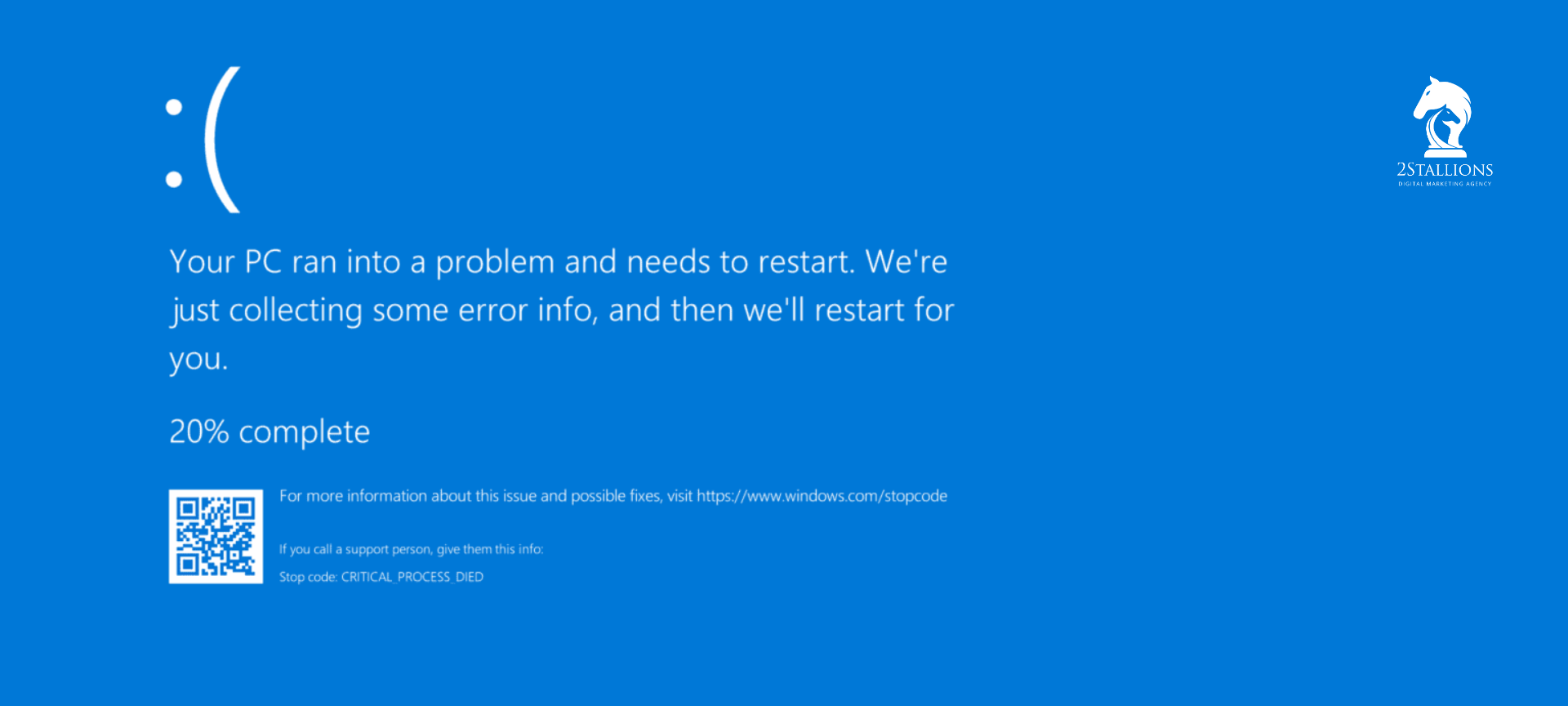Content
SHARE

Few incidents in the digital security landscape have garnered as much global attention as the recent CrowdStrike coding error. This event sent shockwaves through industries worldwide, highlighting how monopolisation leads to a single point of failure, as reliance on a few providers increases vulnerability to widespread issues. As a leading digital marketing agency, we delve into what happened with CrowdStrike, its implications, and how it has affected various industries.
What is CrowdStrike?
CrowdStrike is a renowned cybersecurity technology company specialising in endpoint security, threat intelligence, and cyber attack response services. Established in 2011, the company has built a reputation for its Falcon platform, which provides comprehensive protection against cyber threats. CrowdStrike’s innovative solutions have made it a trusted name in safeguarding data for high-profile clients, including major corporations, financial institutions, and government entities.
The Incident: What Happened?
A massive outage was caused by what was supposed to be a routine update from the cybersecurity company. The software update resulted in a major global IT outage, affecting millions of Windows computers.
The software update caused cascading chaos last Friday, engulfing global businesses from airports and banks to retail and law enforcement. It left numerous industries in turmoil as they struggled to mitigate the impact.
The Coding Error
CrowdStrike released an update with a critical coding error. This flaw triggered the notorious “Blue Screen of Death” (BSOD) on Windows systems, rendering them inoperable. The error propagated rapidly due to the automated update systems used by most enterprises.
Immediate Impact
Although the issue stems from America, the worldwide disruption is unmistakable, as reported by many news outlets. Businesses, banks, hospitals and airlines were among the worst hit, with some still struggling to restore their systems fully today.
- Financial Institutions: Banks and trading platforms experienced downtimes, affecting transactions and market operations. This resulted in significant economic losses and eroded customer trust.
- Healthcare Systems: Hospitals and clinics faced disruptions in accessing patient records, delaying treatments and putting lives at risk.
- Government Services: Essential services were halted, impacting everything from public safety to administrative functions.
- Retail and E-commerce: Point-of-sale systems crashed, leading to lost sales and frustrated customers. Online platforms experienced downtime, affecting global supply chains.
The Role of Industry Monopolisation
Industry monopolisation in cybersecurity creates a single point of failure affecting 8.5 million users worldwide, where reliance on a few dominant providers heightens vulnerability to widespread issues. This concentration limits innovation and leads to complacency, as fewer players drive the market.
When a major provider encounters a problem, its impact is magnified across the industries that depend on its services, causing systemic risks and cascading failures. Diversifying solutions and fostering competition are essential to mitigate these vulnerabilities and enhance resilience.
The Endpoint Protection Industry
A few dominant companies, including CrowdStrike, largely control the cybersecurity landscape. The top Crowdstrike’s competitors in the Endpoint Protection category are McAfee ePO with 21.29%, SentinelOne with 9.61%, Duo Security with 7.77% market share.
This concentration of power by CrowdStrike leads to potential vulnerabilities:
- Lack of Competition: With fewer players, there’s less pressure to innovate, resulting in stagnation and a lack of diverse solutions.
- Complacency Risk: Dominant companies may become complacent, prioritising profits over rigorous testing and quality control.
- Single Point of Failure: When a single company experiences issues, the impact is magnified across industries that depend on its services.
- Systemic Risk: A problem within one major player can quickly cascade through interconnected systems worldwide.
A Wake-Up Call for Cybersecurity
The CrowdStrike breach is a stark reminder that no organisation is immune to cyber threats. It has sparked a global conversation about the importance of robust cybersecurity measures and the need for continuous vigilance.
Here are some key takeaways:
1. Enhanced Security Protocols
Organisations must adopt a proactive approach to cybersecurity by implementing advanced threat detection and response systems. Regular security audits and vulnerability assessments are essential to identify and mitigate potential risks.
2. Zero Trust Architecture
The breach has highlighted the importance of a Zero Trust security model, which assumes that threats can exist inside and outside the network. Enforcing strict access controls and continuously monitoring user activity can minimise the risk of unauthorised access.
3. Employee Training
Human error remains a significant factor in cybersecurity breaches. Comprehensive training programs can equip employees with the knowledge and skills to recognise and respond to potential threats, reducing the likelihood of successful attacks.
4. Collaboration and Information Sharing
In the face of sophisticated cyber threats, collaboration between organisations, industries, and governments is crucial. Sharing threat intelligence and best practices can help build a collective defence against cyber adversaries.
Financial Impact and the Need for Redundancies
The CrowdStrike breach has highlighted the critical financial impact of cyberattacks. Businesses across industries face increased costs related to enhanced security measures, regulatory fines, and potential loss of revenue due to decreased customer trust. In light of this, the need for redundancies and diversified cybersecurity solutions has never been more apparent.
Avoiding Over-Reliance on Single Providers
The incident underscores the dangers of over-reliance on a single cybersecurity provider. Diversifying security vendors can mitigate risks, ensuring that a breach in one system does not compromise the entire network. Organisations should consider a multi-layered approach, incorporating various security solutions to provide comprehensive protection.
Investing in Redundancy Measures
Implementing redundancy measures, such as backup systems and failover protocols, is essential to maintaining business continuity in a cyberattack. Regularly updated backups and robust disaster recovery plans can minimise downtime and financial losses.
Continuous Monitoring and Adaptation
Cyber threats are evolving, necessitating continuous monitoring and adaptation of security measures. Organisations should invest in advanced threat detection and response systems, regularly update their security protocols, and stay informed about the latest cyber threats.
Employee Training and Awareness
Human error remains a significant factor in cybersecurity breaches. Comprehensive training programs can equip employees with the knowledge and skills to recognise and respond to potential threats, reducing the likelihood of successful attacks.
What If This Happens Again?
If a similar incident occurs again, the financial and operational impacts could be even more severe. Businesses must remain vigilant and proactive, continually assessing and enhancing their cybersecurity measures to protect against future breaches.
Preventing Future Outages
Diversifying cybersecurity solutions is crucial for mitigating risks associated with industry monopolisation. Encouraging competition by supporting startups and smaller firms can lead to innovative and diverse solutions, reducing dependency on a few major players.
Organisations should adopt a multi-vendor strategy, spreading their cybersecurity needs across various providers to minimise vulnerabilities. This approach fosters innovation and enhances resilience by ensuring that a failure in one system does not result in widespread outages.
Implementing robust testing protocols is essential for preventing future incidents. Automated and real-world simulations can detect errors before deployment, ensuring software reliability. Enhancing communication between providers and clients is key, with proactive alerts and collaborative platforms facilitating quick responses to emerging threats.
Building resilient systems with redundancy, backup, and continuous monitoring ensures operational continuity during outages. These strategies collectively strengthen the cybersecurity landscape, safeguarding against potential disruptions.
Conclusion
The CrowdStrike breach has served as a wake-up call for industries worldwide, emphasising the critical importance of robust cybersecurity measures and financial preparedness. For administrators still affected by the CrowdStrike malware, we recommend utilising Microsoft’s new recovery tool to help mitigate the issue.
You can find more information and download the recovery tools provided by Microsoft. Organisations must remain vigilant and proactive to protect sensitive data as digital threats evolve. At 2Stallions, we are committed to helping our clients navigate these challenges, providing cutting-edge solutions to safeguard their digital assets and ensure business continuity.












